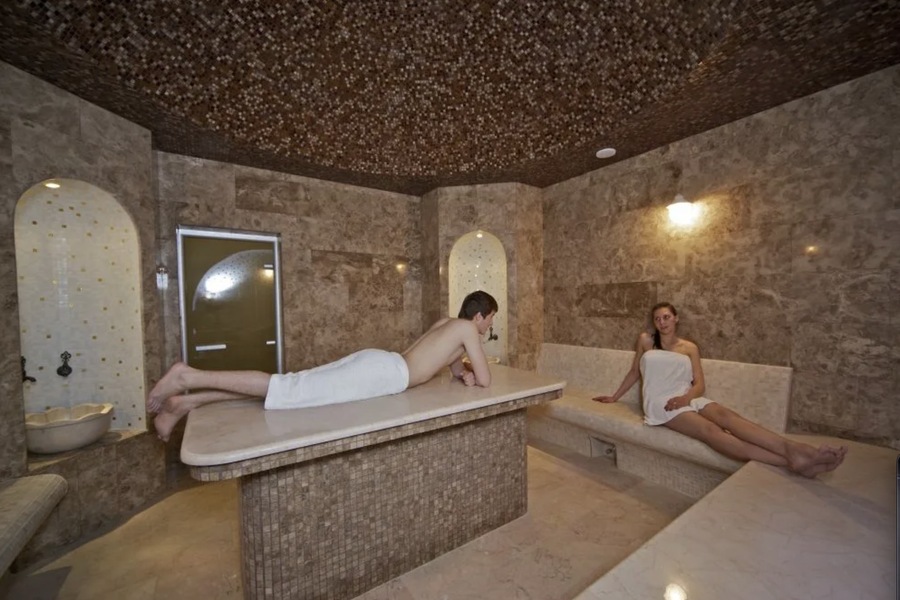Turkish Hamam vs. Finnish Sauna: Understanding the Differences, Benefits, and Unique Experiences

Visiting a Turkish hamam or Finnish sauna is a fantastic way to unwind, relieve muscle tension, enhance skin health, and improve your mood. Despite the convenience of modern home baths, these traditional steam rooms continue to be popular due to their health benefits and unique experiences. Both the hamam and sauna have ancient origins, dating back to the 5th–7th centuries AD, and are still widely enjoyed today. While both share the common goal of promoting relaxation and health, the Turkish hamam and Finnish sauna differ significantly in their climates, materials, and overall experiences. In this article, we will dive deep into the details of both, exploring their benefits, key differences, and what you can expect from Elysium Spa experiences.
Page Contents
What is a Turkish Hamam?
A Turkish hamam, often referred to as a “Turkish bath,” is a centuries-old tradition that dates back to the Roman and Byzantine empires, later adapted and popularized by the Ottomans. The hamam experience revolves around steam, relaxation, and thorough cleansing of the body. The hamam offers a humid environment with nearly 100% humidity and temperatures ranging between 40-45°C, much cooler than a sauna but with high moisture levels.
The architecture of a hamam is also unique. Traditional hamams are built from marble or stone, with large, heated platforms where individuals lay down to sweat. The steam is generated by pouring water over heated stones, enveloping the room in warm, moist air. The process typically includes a sequence of steps, such as exposure to steam, exfoliation with a rough mitt (known as a “kese”), followed by a luxurious foam massage, which leaves the skin feeling smooth and refreshed.
Benefits of Visiting a Hamam
1. Improved Respiratory Function
The warm, humid air of a hamam helps open up airways and promotes deeper, more controlled breathing. This can be particularly beneficial for individuals with respiratory conditions such as asthma or bronchitis, as the steam clears mucus and improves lung function. Regular visits to a hamam may also reduce the frequency of colds and respiratory infections.
2. Enhanced Blood Circulation
The heat in a hamam gently dilates blood vessels, improving blood flow throughout the body. This enhanced circulation brings more oxygen to vital organs and tissues, helping to fight against stagnation and promoting overall cardiovascular health.
3. Skin Cleansing and Rejuvenation
One of the most prominent features of a hamam is its skin-cleansing properties. The combination of steam, exfoliation, and massage removes dead skin cells, unclogs pores, and leaves the skin feeling soft and nourished. It also prepares the skin for tanning, making the tan last longer and adhere more evenly.
4. Detoxification
The hamam encourages heavy sweating, which helps the body expel toxins. The open pores allow for a deep cleanse, ridding the body of impurities such as heavy metals and environmental pollutants that accumulate over time.
5. Stress Relief and Mental Clarity
After a hamam session, many people report feeling mentally and physically lighter. The heat and massage promote deep relaxation, which reduces anxiety, lowers cortisol levels, and improves sleep quality. It also boosts the production of serotonin, which enhances your overall mood.
6. Boosted Metabolism
The exposure to heat in a hamam helps stimulate protein metabolism and oxidative processes in the body. This normalization of metabolism can aid in weight loss and help maintain a healthy body weight when combined with a balanced diet and regular physical activity.
7. Muscle Relaxation and Pain Relief
Muscles can greatly benefit from the hamam experience. The heat, followed by a massage, helps to relieve muscle tension, eliminate soreness, and improve flexibility. This is particularly useful after workouts or strenuous physical activity, as it helps to prevent cramps and stiffness.

What is a Finnish Sauna?
The Finnish sauna, another ancient tradition, originates from Northern Europe and is vastly different from the hamam in terms of atmosphere and experience. Finnish saunas are known for their dry heat, with temperatures typically ranging between 80–100°C, but sometimes climbing as high as 130°C. The humidity levels in a sauna are very low, usually between 10-20%, making the experience much hotter but less steamy than a hamam.
A Finnish sauna is traditionally built from natural wood, which absorbs the heat and provides a pleasant, earthy aroma. The sauna operates with heated stones over which water is occasionally poured to create a short burst of steam, known as “löyly.” Sauna sessions often involve alternating between the hot room and cold water immersion, which helps invigorate the body and improve circulation.
Benefits of Visiting a Sauna
1. Strengthening the Immune System
One of the key benefits of regular sauna use is the hardening of the body. The extreme heat, followed by cold exposure, improves the body’s resilience to harmful viruses and infections. This “thermal training” enhances immune system function, helping to prevent common colds and flu.
2. Detoxification of the Body
The dry heat of a sauna induces intense sweating, which helps to flush out toxins from the body. This includes heavy metals like lead, mercury, and cadmium, which are often found in urban environments. The sauna also clears out sebum and dead skin cells, leaving the skin clean and refreshed.
3. Muscle Recovery and Endurance
For athletes or anyone engaging in regular physical activity, the sauna is an excellent tool for muscle recovery. The heat helps relax tight muscles, increase blood flow, and speed up the repair of micro-tears in muscle tissue. It also improves muscle endurance, making it an excellent post-workout therapy.
4. Mental Health and Well-being
The heat in the sauna stimulates the release of endorphins, the body’s natural painkillers, which can help reduce feelings of stress, anxiety, and depression. The sense of relaxation and euphoria that follows a sauna session is a key reason why people continue to incorporate sauna sessions into their wellness routines.
5. Pain Relief
For individuals suffering from chronic pain conditions, such as arthritis or tension headaches, the sauna provides a natural form of pain relief. The heat relaxes muscles, reduces inflammation, and improves circulation, all of which help alleviate discomfort.
6. Cardiovascular Benefits
Regular sauna use has been shown to have significant cardiovascular benefits. The heat exposure improves the elasticity of the arteries, lowers blood pressure, and reduces chronic inflammation in the body. Over time, these benefits contribute to improved heart health and a reduced risk of cardiovascular diseases.

Key Differences Between a Turkish Hamam and a Finnish Sauna
Though both steam rooms offer numerous health benefits, there are several key differences between the Turkish hamam and Finnish sauna.
1. Humidity and Temperature
– Hamam: Nearly 100% humidity with moderate heat (40-45°C).
– Sauna: Low humidity (10-20%) with high heat (80-130°C).
2. Interior Materials
– Hamam: All surfaces are made from stone or marble, creating a cool, easy-to-clean environment.
– Sauna: Natural wood is used for both the structure and seating, contributing to its dry, aromatic atmosphere.
3. Experience
– Hamam: A visit to a hamam is more ritualistic, typically involving steam, exfoliation, and massage.
– Sauna: The sauna experience is more about alternating between extreme heat and cold, often without massage services.
4. Equipment
– Hamam: Includes massage tables and pools of varying temperatures for water immersion.
– Sauna: Typically does not have pools, but may feature a plunge pool or cold showers for cooling off.
Conclusion: Choosing Between a Hamam and a Sauna
The choice between a Turkish hamam and a Finnish sauna depends on personal preferences and what you hope to gain from the experience. If you enjoy high humidity and prefer a gentler form of heat that allows for extended relaxation and skin rejuvenation, the hamam is an excellent choice. The sauna, on the other hand, is better suited for those who enjoy intense heat and a quicker, more invigorating session with greater benefits for muscle recovery and mental well-being.
In Dubai, you can experience the best of both worlds at Elysium Spa in the Tecom area. Elysium Spa offers a Traditional Hammam experience that includes steam bathing, exfoliation, and massage for a price of 400 AED for 90 minutes. Whether you’re in the mood for a relaxing Turkish hamam or the stimulating heat of a Finnish sauna, both experiences will leave you feeling refreshed and rejuvenated.

